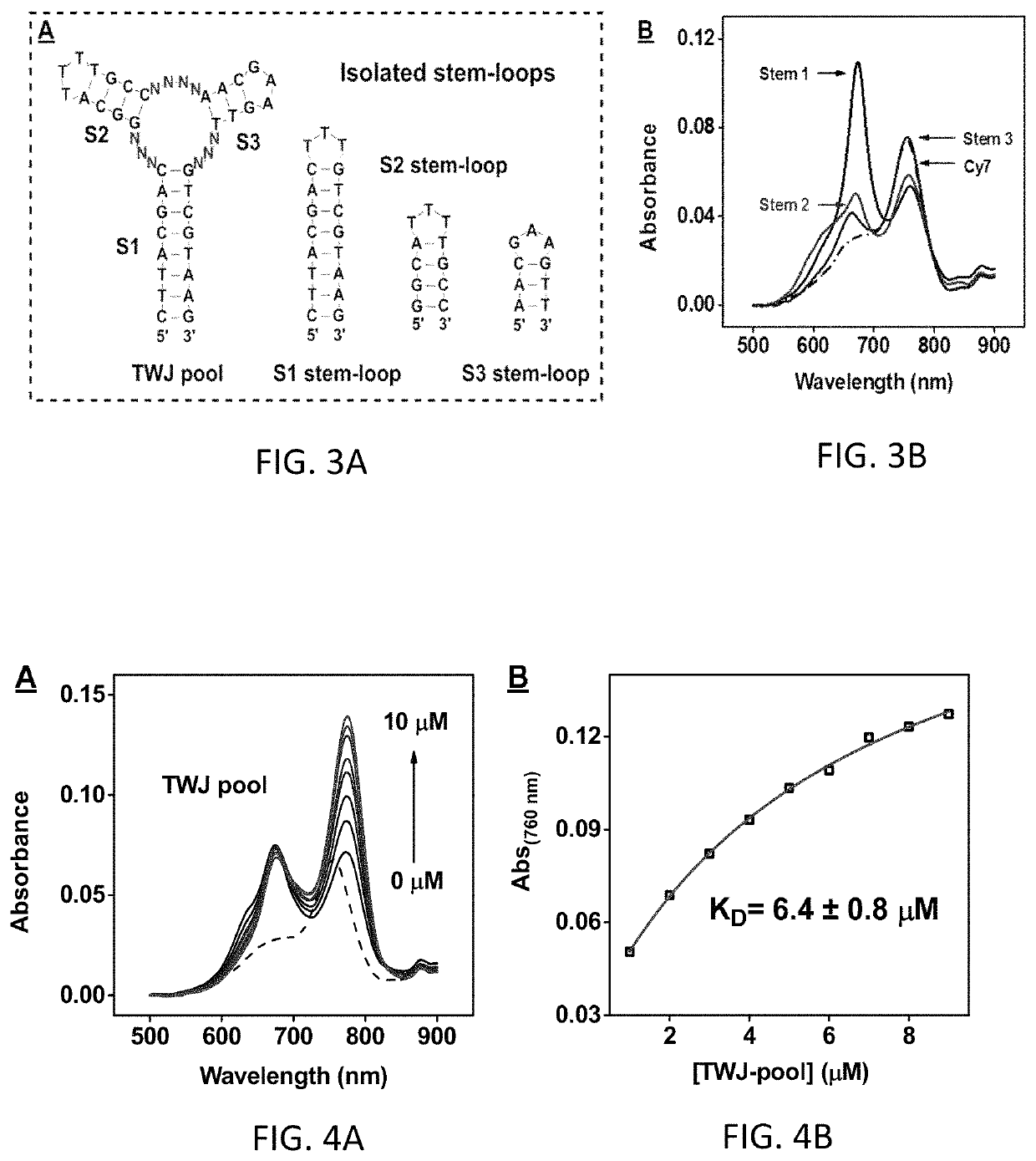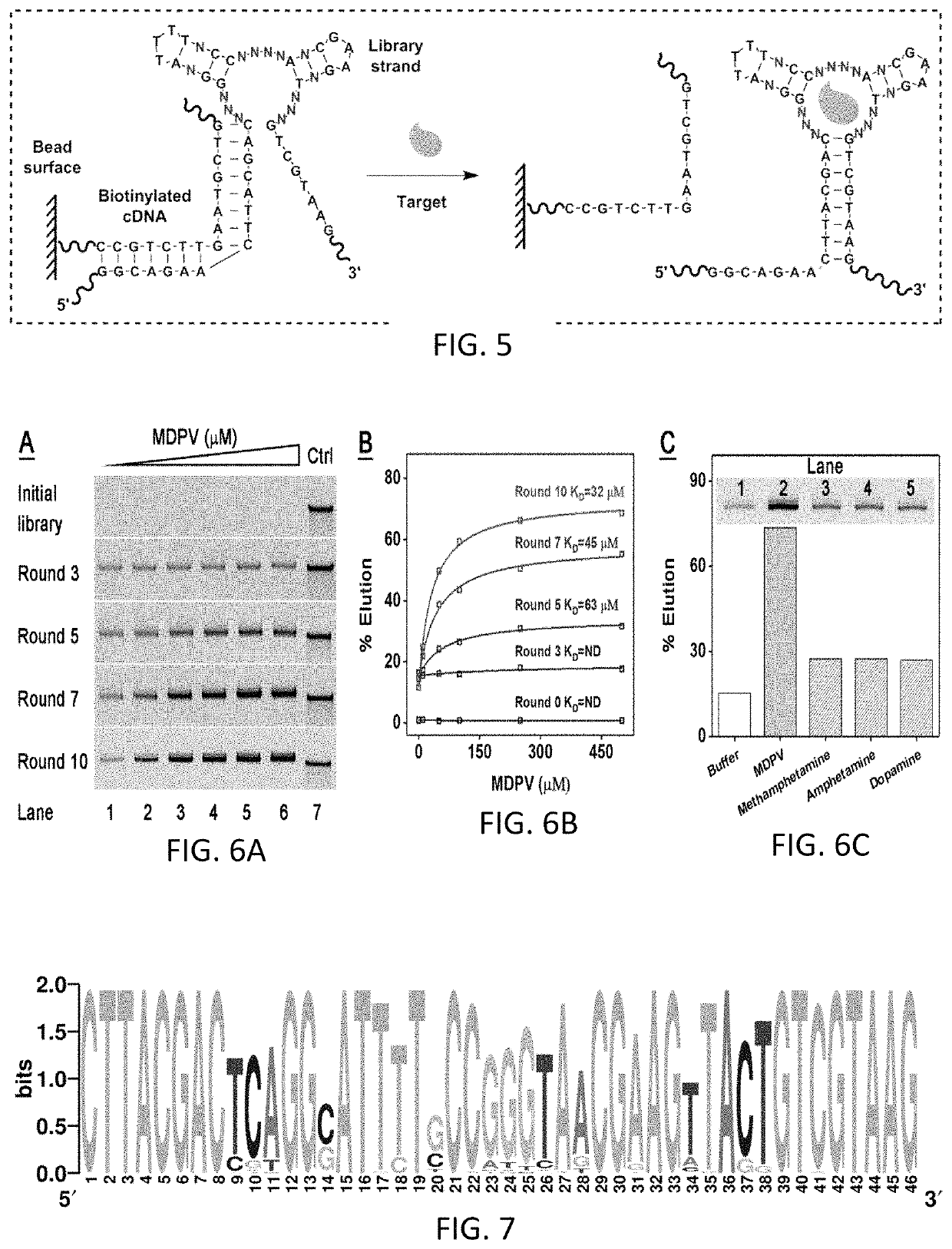Materials and methods for rapid and specific detection of synthetic cathinones
a synthetic cathinone, rapid technology, applied in the field of biosensors, can solve the problems of difficult to generate a measurable signal at target concentrations more than 100-, time-consuming methods, complex sample preparation, etc., and achieve the effect of facilitating interference-free detection
- Summary
- Abstract
- Description
- Claims
- Application Information
AI Technical Summary
Benefits of technology
Problems solved by technology
Method used
Image
Examples
example 1
echanism of Cy7 to TWJs
[0156]Cy7 (FIG. 1A) specifically binds to the TWJ-structured binding domain of a cocaine-binding aptamer via hydrophobic interactions.19 Cocaine displaces Cy7 from the TWJ, resulting in a significant reduction in the absorbance of the dye at 760 nm. DIS- and DOG-binding aptamers both contain TWJ-structured target-binding domains. The generality of the Cy7-displacement assay was demonstrated using these two aptamers. Specifically, Cy7 was immediately displaced from both aptamers upon the addition of their respective targets, yielding a significant decrease in the absorbance of the dye at 760 nm (FIGS. 2A-2C).
[0157]To confirm that Cy7 indeed binds to TWJs in a sequence-independent manner, a 46-nt structured DNA pool containing a constant TWJ structure formed by three fully complementary stems (S1, S2, and S3) and 10 randomized nucleotides within the junction itself (FIG. 1A and Table 1, TWJ pool) was chemically synthesized. After mixing 2 μM Cy7 with 10 μM TWJ p...
example 2
esign and Isolation Process
[0161]A new small-molecule-specific aptamer isolated from a TWJ-containing library can be directly adopted into a label-free Cy7-displacement assay. A structured library was generated by extending both termini of the TWJ pool by 12 nt to create partial PCR primer binding sites (FIG. 5, Table 1, library). Changes in the sequence adjacent to the TWJ binding domain greatly affect the affinity of a cocaine-binding aptamer.14,15 With this in mind, one base-pair in both stems 2 and 3 was randomized to further enhance the potential target-binding affinity of the aptamer. The resulting library is designed to primarily form TWJ-structured target-binding domains. Although there is small possibility to have non-TWJ-structured aptamers in the final enriched pool, these sequences can be identified and removed after sequencing. It should be noted that the randomness of this library (414 sequences) is considerably lower than many reported SELEX libraries.8,16,17 However,...
example 3
haracterization and Development of the Label-Free Cy7-Displacement Assay
[0164]The binding affinity of MA was determined using isothermal titration calorimetry (ITC), titrating 1 mM MDPV into a 20 μM solution of the aptamer. It is shown that MA binds MDPV with a KD of 6.1±0.2 μM (FIG. 8A). Binding is driven by a negative enthalpy change (ΔH=−11.0±0.2 kcal / mol) but with a moderate entropy cost (ΔS=−3.9±0.2 kcal / mol) due to the fact that MDPV is constrained within the TWJ binding domain. It was anticipated that Cy7 would also hind to the TWJ domain of MA but could be displaced by MDPV. This was confirmed by performing an ITC experiment in which we titrated 1 mM MDPV into 20 μM Cy7-MA complex (1:1). The presence of Cy7 did not significantly reduce the MDPV affinity of MA (KD=7.0±0.7 μM) (FIG. 8B). However, the binding heat (ΔH=−6.3±0.2 kcal / mol) was notably lower than in the absence of Cy7 (ΔH=−11.0±0.2 kcal / mol), indicating that a certain amount of energy was required for target-induce...
PUM
| Property | Measurement | Unit |
|---|---|---|
| pH | aaaaa | aaaaa |
| temperature | aaaaa | aaaaa |
| molar ratio | aaaaa | aaaaa |
Abstract
Description
Claims
Application Information
 Login to View More
Login to View More - R&D
- Intellectual Property
- Life Sciences
- Materials
- Tech Scout
- Unparalleled Data Quality
- Higher Quality Content
- 60% Fewer Hallucinations
Browse by: Latest US Patents, China's latest patents, Technical Efficacy Thesaurus, Application Domain, Technology Topic, Popular Technical Reports.
© 2025 PatSnap. All rights reserved.Legal|Privacy policy|Modern Slavery Act Transparency Statement|Sitemap|About US| Contact US: help@patsnap.com



